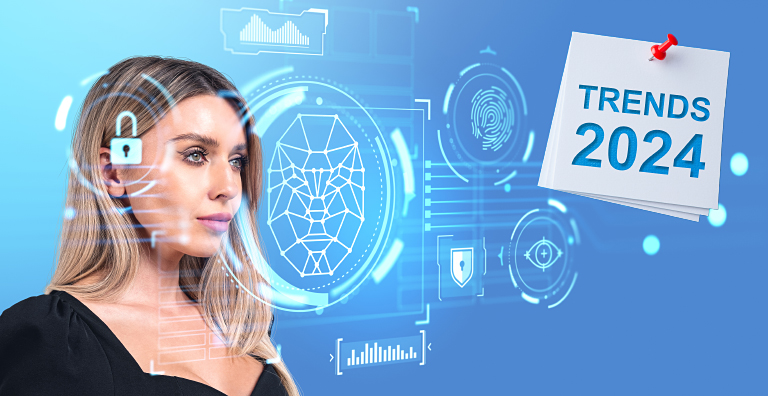10 Biometric Trends to Watch in 2024
The world of biometrics is constantly evolving, and 2024 promises to be a transformative year as people continue to embrace the technology’s value and use cases rapidly expand.
Here are 10 key trends to watch in 2024:
- The Rise of Multimodal Authentication — While fingerprint biometrics remain popular, we'll see increased adoption of multi-factor authentication (MFA) using combinations of facial recognition, voice analysis, iris scans and even gait recognition. This offers enhanced security and caters to individual preferences.
- Liveness Detection Takes Center Stage — Spoofing biometrics is a growing concern, so liveness detection technologies — like eye blinking or challenge-response mechanisms — will be integral to ensure genuine users are behind each biometric authentication attempt.
- Continuous Authentication Goes Mainstream — Static one-time authentication at initial log-in is giving way to continuous monitoring of users throughout sessions. Expect to see this in applications like secure online banking and corporate networks.
- Biometrics at the Edge — With the growth of edge computing, biometric processing is shifting away from centralized servers to on-device platforms. This reduces bandwidth constraints, improves performance, enhances privacy and enables offline authentication in areas with limited connectivity.
- Behavioral Biometrics Emerge — Analyzing user behavior patterns, such as keystrokes, mouse movements and typing patterns, can paint a distinct picture of a user. Expect to see more integration of these behavioral biometrics for enhanced security and user authentication.
- Biometric Integration with the Internet of Things (IoT) — Smart homes, wearables and even connected cars will increasingly leverage the speed, accuracy and security provided by biometrics for personalized experiences and access control. Imagine your refrigerator recognizing you and suggesting personalized meal plans, or your car adjusting settings based on your preferences as soon as your presence is detected.
- Frictionless Authentication in Public Spaces — Airports, stadiums and border crossings are adopting easy-to-use and self-service biometric solutions for faster and more convenient identification to elevate the user experience. Envision walking through immigration checkpoints without needing to show physical documents, all while maintaining layers of digital protection based on biometric credentials.
- Ethical Considerations Take Priority — As biometrics become more ingrained in society, discussions around data privacy, matching bias in algorithms and potential misuse will continue. Expect stricter regulations and more responsible development practices as leading biometric providers express commitments to data diversity to help reduce AI matching bias, and foster inclusivity and fairness in applications.
- Data Security and Transparency — Concerns about data privacy and security will remain a major focus, with regulations like GDPR and CCPA shaping how biometric data is collected, stored and used. Expect increased transparency and user control over biometric data.
- AI-Powered Biometrics — Artificial intelligence will play a crucial role in enhancing biometric accuracy, detecting spoofing attempts and identifying emerging threats. Expect to see AI-driven algorithms continuously learn and adapt, making biometric systems even more robust and reliable.
This is just a glimpse into the fascinating future of biometrics and the importance of reliable identity assurance. As the technology advances and ethical considerations are addressed, biometrics will continue to reshape our interactions with the world around us to offer greater convenience, security and personalization as people of all ages, races and backgrounds are empowered by their unique biometric markers.
Additional Resources
- Learn more about HID’s AI-powered facial recognition technologies
- Find out more about HID fingerprint biometrics
- Explore HID’s comprehensive biometric portfolio
- Subscribe to the HID Biometric Beat monthly eNewsletter
